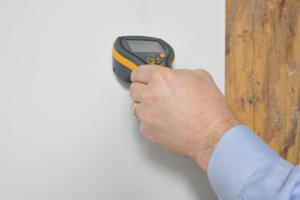Moisture Testing in Home Inspections: What It Is and Why It Matters
The  Vital Role of Moisture Testing in Mason Home Inspections
Vital Role of Moisture Testing in Mason Home Inspections
When you schedule a home inspection through Mason Home Inspections, you’re not just getting a surface-level overview of a property — you’re gaining insight into the long-term safety, value, and livability of the home. One of the most critical yet often overlooked parts of any thorough inspection is moisture testing. This process helps uncover what may be hidden behind the walls or beneath finished surfaces and plays a significant role in identifying current or potential issues that can lead to major headaches down the road.
Moisture intrusion is one of the leading causes of structural damage, air quality problems, and costly repairs in residential homes. Whether it’s the slow seep of groundwater into a basement wall or a hidden plumbing leak inside an upstairs bathroom wall, excess moisture almost always causes more harm the longer it goes undetected. That’s why every inspection I conduct includes a non-invasive moisture test of both above-grade and below-grade walls using a specialized moisture meter.
At Mason Home Inspections, we test for moisture to protect you from the risks you can’t see — even when the drywall looks perfectly clean or the basement floor appears dry.
Why Moisture Testing Matters
Moisture testing is an essential component of a complete inspection because water can be both sneaky and destructive. It can compromise the structural integrity of framing, insulation, and foundation materials. It can lead to mold growth, pest infestations, rot, and even weaken electrical systems. And the worst part? Many moisture problems aren’t visible until the damage is advanced — which is often too late to fix without spending thousands.
Using an electronic moisture meter, I’m able to scan key areas of the home’s walls and ceilings to detect any signs of elevated moisture. This gives us a clearer picture of what’s happening behind the scenes, even when no water stains or visible mold is present.
Below Grade (Basement) Moisture
Basements are especially prone to water intrusion due to their location below the ground. If moisture is detected on the interior of a basement wall, it could indicate a failure in the home’s waterproofing system, improper grading outside, blocked or missing gutters, or even cracks in the foundation. Left unresolved, these issues can cause spalling concrete, crumbling mortar joints, or full-scale mold colonization in insulation and framing.
When I find elevated moisture levels in a basement, I always recommend further evaluation to determine the source. In some cases, it could be as simple as poor humidity control, while other times it might require drainage correction or exterior sealing.
Above Grade (Living Areas) Moisture
Moisture found in upper-level walls and ceilings is often a red flag for roof leaks, plumbing failures, or condensation issues. These types of problems might stem from old or damaged flashing, leaky shower valves, or even poor attic ventilation. Catching this early is crucial — not only to protect the structural elements of the home, but also to prevent mold growth that can impact air quality and your family’s health.
Peace of Mind for Buyers and Sellers
Whether you’re buying your first home or preparing to list a property, moisture testing gives you peace of mind. Buyers can move forward confidently, knowing hidden moisture isn’t waiting to cause trouble. Sellers can proactively fix issues before they become deal breakers.
At Mason Home Inspections, I don’t just check boxes — I look deeper. Moisture testing is one of the ways I ensure your home is safe, sound, and ready for whatever comes next.


Leave a Reply
Want to join the discussion?Feel free to contribute!